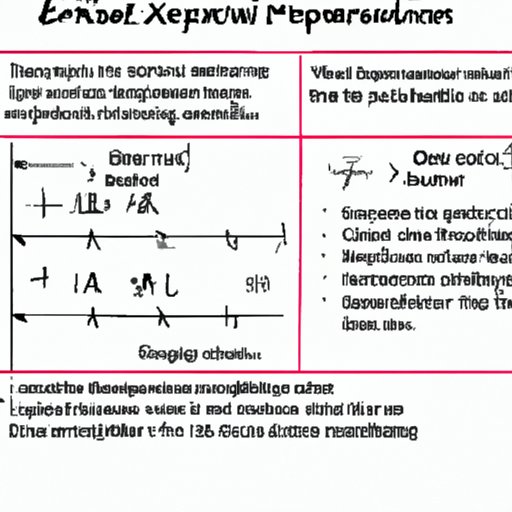
I. Introduction
Finding the x-intercept is a crucial skill for anyone working with linear equations. Whether you’re analyzing data in finance or solving problems in physics, understanding how to identify and use x-intercepts is essential. This article will provide a step-by-step guide for finding x-intercepts, as well as real-world examples of how this concept can be used. We’ll also cover common mistakes to avoid and offer interactive exercises to help you practice this skill.
II. Basics of X-Intercepts
The x-intercept is the point on the graph of a function where the graph intersects the x-axis. At this point, the value of y is zero, and the value of x is determined by the function. Simply put, an x-intercept represents the value of x when y is equal to zero. In linear equations, the x-intercept is the point where the line crosses the x-axis.
Linear equations take the form y = mx + b, where m is the slope of the line and b is the y-intercept. The slope of the line represents the rate of change of y with respect to x, while the y-intercept is the point where the line crosses the y-axis. The x-intercept, on the other hand, is the point where the line crosses the x-axis, so the value of y is zero.
Not all equations have x-intercepts. Only equations in which y can be equal to zero have x-intercepts. For example, quadratic equations, which take the form y = ax^2 + bx + c, can have one or two x-intercepts, depending on the value of the discriminant.
III. Step-by-Step Guide for Finding X-Intercepts
Now that we understand the basics of x-intercepts, let’s take a closer look at how to find them. Here’s a step-by-step guide:
Step 1: Understand the equation. Before you can find the x-intercept, you need to understand the equation you’re working with. Identify the values of a, b, and c in the equation y = ax^2 + bx + c.
Step 2: Simplify the equation. To find the x-intercept, you need to set y equal to zero and solve for x. Simplify the equation by replacing y with zero, then solve for x.
Step 3: Find the x-intercept. Once you’ve simplified the equation and solved for x, you should have the value of x when y is equal to zero. This is the x-intercept of the equation.
Let’s look at an example problem to see how this process works:
Example: Find the x-intercept of the equation y = 2x + 4.
Step 1: Identify the values of m and b. In this case, m = 2 and b = 4.
Step 2: Simplify the equation. Replace y with zero and solve for x:
0 = 2x + 4
-4 = 2x
-2 = x
Step 3: Find the x-intercept. The value of x when y is equal to zero is -2. Therefore, the x-intercept of the equation y = 2x + 4 is (-2, 0).
By following these steps, you can find the x-intercept of any linear equation. However, it’s important to note that more complex equations may require different methods to simplify and solve for x.
IV. Real-World Applications of X-Intercepts
The concept of x-intercepts has many real-world applications. In finance, x-intercepts can be used to calculate break-even points, which determine the level of sales or revenue needed to cover costs. X-intercepts are also used in engineering to design structures that can withstand certain forces. In physics, x-intercepts can be used to determine the velocity and acceleration of moving objects.
Let’s look at an example to see how x-intercepts can be used in finance. Suppose you’re starting a business that sells handcrafted goods. You need to determine the break-even point, which is the level of sales you need to cover your costs. You have fixed costs of $5,000 and variable costs of $10 per unit. You sell your products for $50 each. The break-even equation is:
0 = 50x – 10x – 5000
Where x is the number of units sold. Simplifying the equation, we get:
0 = 40x – 5000
x = 125
The x-intercept of this equation is the break-even point, which is 125 units. This means that you need to sell 125 units to cover your costs. Any sales beyond this point will generate a profit.
In this way, x-intercepts can be used to solve real-world problems in various fields.
V. Common Mistakes to Avoid
When finding x-intercepts, there are a few common mistakes that people often make. Here are some tips for avoiding these mistakes:
Mistake #1: Assuming that an equation has an x-intercept without checking. Not all equations have x-intercepts, so be sure to check whether it’s possible before starting the process.
Mistake #2: Forgetting to simplify the equation before solving for x. Simplifying the equation by setting y equal to zero is a crucial step in finding the x-intercept.
Mistake #3: Making calculation errors while solving for x. It’s important to be precise when performing calculations to avoid errors.
By keeping these tips in mind, you can avoid common mistakes and find x-intercepts with confidence.
VI. Interactive Exercises
To reinforce your understanding of finding x-intercepts, try out these interactive exercises:
Quiz: Take a quiz to test your knowledge of finding x-intercepts.
Puzzle: Solve a puzzle by finding the x-intercepts of a series of equations.
These exercises can help you practice finding x-intercepts and gain confidence in this skill.
VII. Conclusion
Understanding how to find x-intercepts is a fundamental skill for anyone working with linear equations. By following the step-by-step guide provided in this article, you can find the x-intercept of any equation. Real-world examples show how x-intercepts can be used in various fields, and interactive exercises can help you reinforce your understanding of this concept. By avoiding common mistakes and practicing this skill, you can gain confidence in finding x-intercepts and use this knowledge to solve complex problems.





